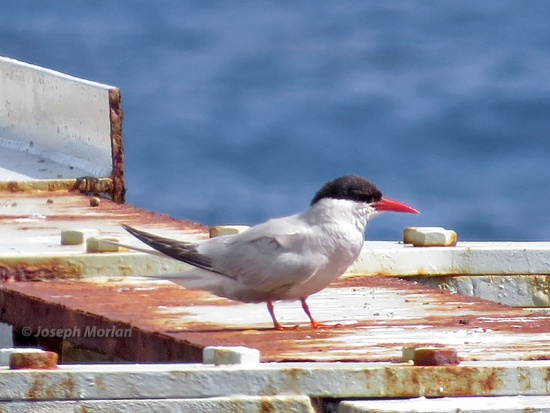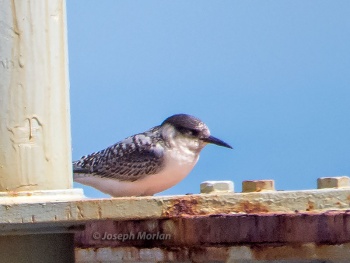
Breeding adult, subspecies tristanensis.
Photo © by Joseph Morlan
Edinburgh of the Seven Seas, Tristan da Cunha, SH. 13 March 2018.
Photo © by Joseph Morlan
Edinburgh of the Seven Seas, Tristan da Cunha, SH. 13 March 2018.
- Sterna vittata
Identification
31-38 cm.
- Pale grey and white
- Black cap when breeding otherwise streaked with white
- Greyish black wing tips
- Dark red or blackish bill.
Juveniles:belly, foreneck, forehead, and breast are white. Grey back, black bill, orange-red legs and feet.
Distribution
Southern Oceans.
Taxonomy
Subspecies
There are 6 subspecies[1]:
- S. v. tristanensis:
- Tristan da Cunha, Gough Island; Amsterdam Island and (possibly) St. Paul Island
- S. v. georgiae:
- South Georgia Island; possibly South Orkney and South Sandwich islands
- S. v. gaini:
- South Shetland Islands
- S. v. vittata:
- Prince Edward, Marion, Crozet and Kerguelen islands

Juvenile, subspecies tristanensisi.
Photo © by Joseph Morlan
Edinburgh of the Seven Seas, Tristan da Cunha, SH. 13 March 2018.
Photo © by Joseph Morlan
Edinburgh of the Seven Seas, Tristan da Cunha, SH. 13 March 2018.
- S. v. bethunei:
- Stewart, Snares, Auckland, Bounty, Antipodes, Campbell islands
- S. v. macquariensis:
- Macquarie Island
S. v. macquariensis is not recognised by all authorities[2]
Coasts and sea.
Behaviour
Diet
The diet includes fish.
Breeding
Up to 3 eggs are laid in a shallow pebble-or shell-lined scrape on the ground, between October and January.
Habitat
References
- Clements, J. F., T. S. Schulenberg, M. J. Iliff, D. Roberson, T. A. Fredericks, B. L. Sullivan, and C. L. Wood. 2017. The eBird/Clements checklist of birds of the world: v2017, with updates to August 2017. Downloaded from http://www.birds.cornell.edu/clementschecklist/download/
- Gochfeld, M., Burger, J. & Garcia, E.F.J. (2018). Antarctic Tern (Sterna vittata). In: del Hoyo, J., Elliott, A., Sargatal, J., Christie, D.A. & de Juana, E. (eds.). Handbook of the Birds of the World Alive. Lynx Edicions, Barcelona. (retrieved from https://www.hbw.com/node/54027 on 13 June 2018).
- Higgins, P.J.; Davies, S.J.J.F. (Eds.) 1996. Handbook of Australian, New Zealand and Antarctic birds. Vol. 3. Snipe to Pigeons. Oxford University Press: Melbourne
- Jaramillo, A. 2003. Birds of Chile. Princeton & Oxford: Princeton Univ. Press. ISBN 978-0691117409
- Sagar, P.M. 2013. Antarctic tern. In Miskelly, C.M. (ed.) New Zealand Birds Online. http://www.nzbirdsonline.org.nz
- Shirihai, H. 2008. Complete Guide to Antarctic Wildlife: Birds and Marine Mammals of the Antarctic Continent and the Southern Ocean. Princeton & Oxford: Princeton Univ. Press. ISBN 978-0691136660
- Avibase
- Wikipedia
Recommended Citation
- BirdForum Opus contributors. (2024) Antarctic Tern. In: BirdForum, the forum for wild birds and birding. Retrieved 31 October 2024 from https://www.birdforum.net/opus/Antarctic_Tern





